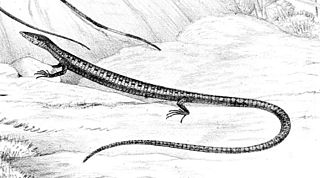
Anadia is a genus of lizards in the family Gymnophthalmidae. The genus is endemic to southern Central America and northern South America.
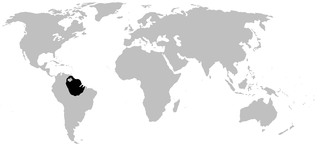
The Tukeit Hill frogs are three species of frog in the genus Allophryne. Originally erected for the species Allophryne ruthveni, the genus was placed as the only member of the subfamily Allophryninae, which was in turn placed in the family Centrolenidae, but they are now considered as the only genus in the monotypic family Allophrynidae.

Hyloscirtus is a genus of Neotropical frogs in the family Hylidae. This genus was resurrected in 2005 following a major revision of the Hylidae, with the distinguishing features being 56 transformations in nuclear and mitochondrial proteins and ribosomal genes. Of these species, 28 species, previously placed in the genus Hyla, were moved to this genus. The fingers and toes of these frogs have wide dermal fringes.
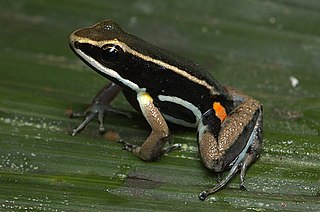
Allobates is a genus of frogs in the family Aromobatidae. They are native to the Central and South Americas, from Nicaragua to Bolivia and Brazil, with one species on Martinique.
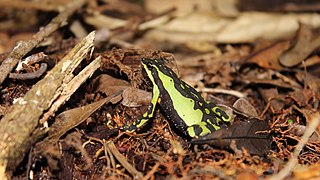
Atelopus pulcher is a species of toad in the family Bufonidae. It is endemic to eastern Peru where it is found in the Huallaga River drainage; its range might extend to Ecuador. Its natural habitats are lowland and premontane tropical forests. It is a diurnal and terrestrial species that breeds in streams.
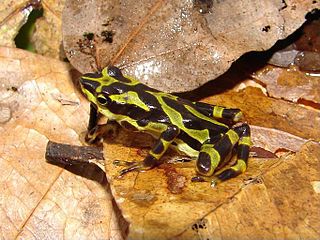
Atelopus spurrelli is a species of toad in the family Bufonidae. It is endemic to Colombia and occurs in the Pacific lowlands and foothills of the Cordillera Occidental. The specific name spurrelli honors Herbert George Flaxman Spurrell, a British physician and zoologist. Common name Condoto stubfoot toad has been coined for this species.

Colostethus panamansis, also known as the Panama rocket frog or (ambiguously) common rocket frog, is a species of poison dart frog. It is found in northwestern Colombia and Panama. It is one of the best studied poison dart frogs; however, until 2004 Colostethus panamansis was considered a synonym of Colostethus inguinalis, and consequently the older literature uses that name.

The blue-bellied poison frog or bluebelly poison frog is a species of frogs in the family Dendrobatidae.

Craugastor raniformis is a species of frog in the family Craugastoridae. It is found in Colombia and Panama. It is a reasonably common species found in humid lowland and montane forests up to 1,500 m (4,900 ft) asl. It is also common in wet pastureland. Furthermore, it is one of the dominant frogs in abandoned mixed farming areas in the coastal Pacific rainforests in Colombia. This adaptable species is not considered threatened.
Craugastor rugosus is a species of rain frog in the family Craugastoridae. It is found in Costa Rica and southwestern Panama, and possibly southern Nicaragua.

The horned marsupial frog, originally named Nototrema cornutum Boulenger after the first describer George Albert Boulenger in 1898), is a species of frog in the family Hemiphractidae. It is an arboreal species found in Colombia, Costa Rica, Ecuador and Panama. Its natural habitats are tropical moist lowland forests and montane cloud forests. It is threatened by habitat loss.
Gastrotheca nicefori is a species of frog in the family Hemiphractidae. It is found in the Andes of Colombia, on the Andean slopes of northern Venezuela, and in the highlands of eastern and central Panama.

Silverstoneia is a genus of poison dart frogs from southern Central America and northern South America, between southwestern Costa Rica and southwestern Colombia. It is named in honour of Phillip A. Silverstone, an expert on dendrobatoid frogs.

Pristimantis is a very large genus of frogs distributed in the southern Caribbean and in Central and South America from Honduras to northern Argentina and southern Brazil. With 570 described species, Pristimantis had more species than any other genus of vertebrate animals. Many of these species genus are endemic to the Northwestern Andean montane forests ecoregion in northwestern South America.

Pristimantis achatinus is a species of frog in the family Craugastoridae. It is found from eastern Panama through Colombia to western Ecuador. Its natural habitats are both lowland and montane habitats: forest clearings, road cuts in forest, and banana, cacao and coffee plantations, as well as in forested areas. It is mostly terrestrial, sometimes occurring off the ground in vegetation. It is a very common frog.

Anomaloglossus is a genus of frogs in the family Aromobatidae. The genus is endemic to the Guiana Shield in northern South America. It used to be placed in the family Dendrobatidae, and is still placed in that family by some sources. The name of the genus, from the Greek anomalos and glossa (=tongue), refers to the unusual tongue bearing the median lingual process, the only unambiguous phenotypic synapomorphy of this genus.

Sachatamia is a small genus of glass frogs. They are found in Central America and northern South America at altitudes below 1,500 m (4,900 ft) above sea level.

Ikakogi is a genus of frogs in the family Centrolenidae. It has been tentatively placed in the subfamily Centroleninae, although more recent analyses suggest that it is the sister group of the clade Centroleninae+Hyalinobatrachiinae.

Leucostethus is a genus of frogs in the family Dendrobatidae, in the subfamily Colostethinae. The frogs are found in the western Amazon rainforest.
Paruwrobates is a genus of frogs in the family Dendrobatidae. The frogs are found in the Pacific slopes of the Andes in southern Colombia and northern Ecuador.
















